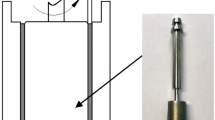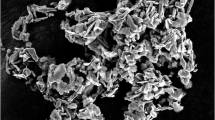Abstract
The rheological behavior of field-dependent smart fluids in both the pre-yield and post-yield regimes is investigated. Typical viscoelastic and viscoplastic models are employed to model the fluids behavior. Viscoelastic models are used widely in the pre-yield regime. Viscoplastic models are also used extensively in both the pre-yield and post-yield regimes. Two smart fluids including a ferromagnetic nanoparticle fluid and an MR fluid are examined here. Using an MCR300 rheometer, the rheological properties of the fluids in both oscillation and rotational mode are measured. In the oscillation mode, the storage and loss moduli versus frequency are measured. In the rotational mode, shear stress, shear rate, viscosity and torque are measured. In the frequency domain, the pre-yield behavior of the ferromagnetic nano-particle fluid is modeled by Kelvin-Voigt solid model. Also, the three-parameter fluid model is used to model the pre-yield behavior of the MR fluid. Two viscoplastic models including Bingham-plastic and Herschel-Bulkley models are selected to model the rheological behavior of fluids in the time domain. Which model is more appropriate depends on the external magnetic field and the shear rate. Both models are used here to model the fluids’ behavior. The models properly predict the results observed in the experiments.
Similar content being viewed by others
References
A. Chaudhuri, N. M. Wereley, R. Radhakrishnan and S. B. Choi, Rheological parameter estimation for a ferrous nanoparticle-based magnetorheological fluid using genetic algorithms, Journal of Intelligent Material Systems and Structures, 17(3) (2006) 261–269.
M. R. Jolly and M. Nakano, Properties and applications of commercial controllable fluids. In: Borgmann, H. (ed.). Actuator 1998. 6th International Conference on New Actuators, Bremen 17–19 June 1998. Bremen: Messe Bremen GMBH. (1998) 411–416.
F. Gandhi and W. A. Bullough, On the phenomenological modeling of electrorheological and magnetorheological fluid preyield behavior, Journal of Intelligent Material Systems and Structures, 16(3) (2005) 237–248.
R. A. Snyder, G. M. Kamath and N. M. Wereley, Characterization and analysis of magnetorheological damper behavior under sinusoidal loading, AIAA Journal, 39(7) (2001) 1240–1253.
R. Stanway, J. L. Sproston and A. K. El-Wahed, Applications of electro-rheological fluids in vibration control: a survey, Smart Materials and Structures, 5(4) (1996) 464–482.
N. D. Sims and N. M. Wereley, Modelling of smart fluid dampers, Proceedings of the 2003 SPIE Conference on Smart Materials and Structures, Passive Damping and Isolation SPIE Vol. 5052 (2003).
N. D. Sims, N. J. Holmes and R. Stanway, A unified modeling and model updating procedure for electrorheological and magnetorheological vibration dampers, Smart Materials and Structures, 13(1) (2004) 100–121.
G. M. Kamath and N. M. Wereley, A nonlinear viscoelasticplastic model for electrorheological fluids, Smart Materials and Structures, 6(3) (1997) 351–359.
G. M. Kamath and N. M. Wereley, Nonlinear viscoelasticplastic mechanisms-based model of an electrorheological damper, Journal of. Guidance, Control, and Dynamics, 20(6) (1997) 1125–1132.
H. U. Oh and J. Onoda, An experimental study of a semiactive magneto-rheological fluid variable damper for vibration suppression of truss structures, Smart Materials and Structures, 11(1) (2002) 156–162.
J. Onoda, H. U. Oh and K. Minesugi, Semiactive vibration suppression with electrorheological-fluid dampers, AIAA Journal, 35(12) (1997) 1844–1852.
H. P. Gavin, Multi-duct ER dampers, Journal of Intelligent Material Systems and Structures, 12(5) (2001) 353–366.
G. M. Kamath, N. M. Wereley and M. R. Jolly, Characterization of magnetorheological helicopter lag dampers, Journal-American Helicopter Society, 44(3) (1999) 234–248.
M. Whittle, R. J. Atkin and W. A. Bullough, Fluid dynamic limitations on the performance of an electrorheological clutch, Journal of Non-Newtonian Fluid Mechanics, 57(11) (1995) 61–81.
D. R. Gamota and F. E. Filisko, Dynamic mechanical studies of electrorheological materials: Moderate frequencies, Journal of Rheology, 35(3) (1991) 399–425.
J. M. Ginder, L. C. Davis and L. D. Elie, Rheology of magnetorheological fluids: Models and measurements, International Journal of Modern Physics, 10(23 & 24) (1996) 3293–3303.
S. Genc and P. P. Phule, Rheology properties of magnetorheological fluids, Smart Materials and Structures, 11(1) (2002) 140–146.
Q. Sun, J. X. Zhou and L. Zhang, An adaptive beam model and dynamic characteristics of magnetorheological materials, Journal of Sound and Vibration, 261(2) (2003) 465–481.
Author information
Authors and Affiliations
Corresponding author
Additional information
This paper was recommended for publication in revised form by Associate Editor Seong Beon Lee
Nader Mohammadi received the BSc. in Mechanical Engineering, Tabriz University, Iran in 1998 and the MSc. And PhD. from Univ. of Tehran in 2000 and 20009. He is currently with the Department of Mech. Eng., Azad University, Parand branch, Iran. His field has been noise control and industrial acoustics. He is currently working on sound transmission loss of ER materials.
M. J. Mahjoob (Mohammad Mahjoob Jahromi) received the BSc./MSc. from Univ. of Tehran in 1988 and the Ph.D. from University of Waterloo Canada in 1995, all in Mechanical Engineering. Since 1995, he has been with the School of Mechanical Engineering, University of Tehran, where he is now associate professor and director of NVA and Mechatronics center. His field of interest includes mechatronics, systems dynamics and control.
Rights and permissions
About this article
Cite this article
Mohammadi, N., Mahjoob, M.J., Kaffashi, B. et al. An experimental evaluation of pre-yield and post-yield rheological models of magnetic field dependent smart materials. J Mech Sci Technol 24, 1829–1837 (2010). https://doi.org/10.1007/s12206-010-0607-x
Received:
Revised:
Accepted:
Published:
Issue Date:
DOI: https://doi.org/10.1007/s12206-010-0607-x




